A tutorial to building a content marketing dashboard in Google Analytics
This post is the third in the series Measuring your content marketing efforts. The first two posts are: The Geek Guide to Measuring your Content Marketing Efforts and Introducing Profit Index: Revolutionary Way to Measure your Content Marketing Efforts.
In the first post I outlined the definition of great content and how this greatness can be measured in monetary terms. In the second post I have talked about a new type of index called ‘profit index’, why you need one and how it can be optimized to increase the conversion volumes and sales on your website.
In this post I am going to explain how to create what I believe are two "top notch" dashboards (in Google Analytics) to quickly measure the performance of your content. Let us start with measuring the performance of a piece of content you have just launched.
First Impression Analysis
‘First impression analysis’ is a term I use with regular people (the non-geek people) as it communicates what's involved well and also because I don’t want to scare/confuse them by using the actual term ‘first click interaction’ analysis which require a good knowledge of the terminology used in attribution modelling as a prerequisite. I do the first impression analysis esp. for the recently launched contents to see what people do on the website after they are exposed to a new piece of content such as a ‘blog post’.
I won’t talk about measuring content consumption (visits, pageviews, avg. time on page) or measuring social engagement (number of tweets, facebook likes etc) of content here since that is often covered. Instead, I'm going to explain how to measure the impact of the new content in much more important monetary terms. Achieving content consumption and engagement can be misleading. For example, if you published an infographic on ‘beer consumption in London’ which went viral and you got a lot of consumption and social sharing of your content. If your website sells tea then the infographic you published obviously won’t add economic value to your business bottomline since your piece of content doesn’t align with your business goals.
Let us do the first impression analysis for an example from one of my recently published blog posts: Building A Super Advanced Keyword Performance Dashboard in Google Analytics & Excel. I want to see what people did on my website after reading this post in terms of adding economic value. Here is the step-by-step process:
Step-1: Head to ‘Assisted Conversions’ Report (under Conversions > Multi Channel Funnels)
Step-2: Click on the link ‘First Interaction Analysis’.
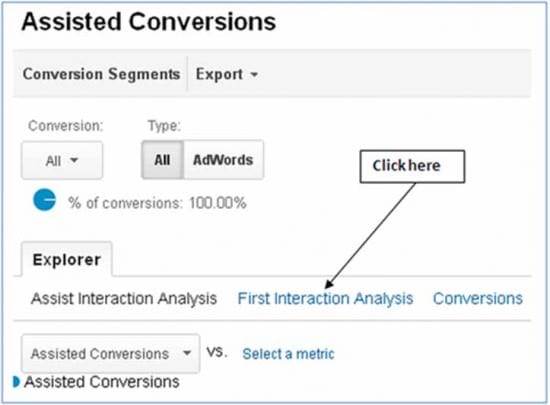
Step-3: Click on the ‘pivot table’ button:

Step-4: Create a pivot table with following specifications:
- Primary Dimension – Source/Medium
- Pivot By: Landing Page URL
- Pivot Metrics: First Click Conversions, First Click Conversions Value
To know more about creating Pivot tables check out this post: The Super Duper Guide to Google Analytics Pivot Tables
Once you have created the pivot table you will see a report like the one below:
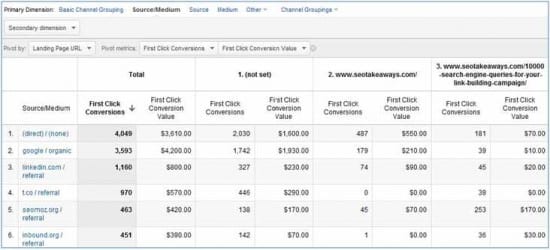
Note: I didn’t assign goal values to some of my goals, so you may see conversion value of $0 in some fields even when I have got conversions. I know this is a crime against humanity 😉 and I have rectified this problem now by assigning goal values to all of my goals. Please make sure that you have assigned correct goal values to all of your goals before you carry out first impression analysis. Without setting goal values, there is no point carrying out such type of analysis.
One other thing that you need to keep in mind is that in case of multi channel funnel reports, a conversion can be a goal conversion or e-commerce transaction or both.
Step-5: Create an advanced filter on the reporting interface:

Step-6: Copy-paste the Request URL of the page you want to analyze. In my case the request URL is going to be: /building-super-advanced-keyword-performance-dashboard-google-analytics-excel/
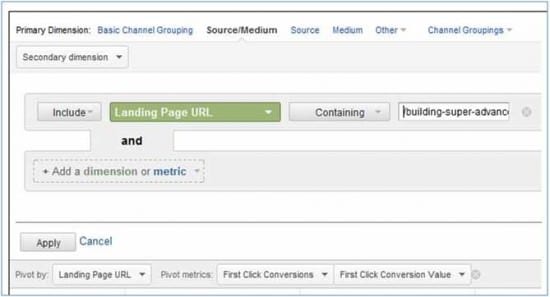
Step-7: Once you have clicked on the ‘Apply’ button you will see a report similar to the one below:
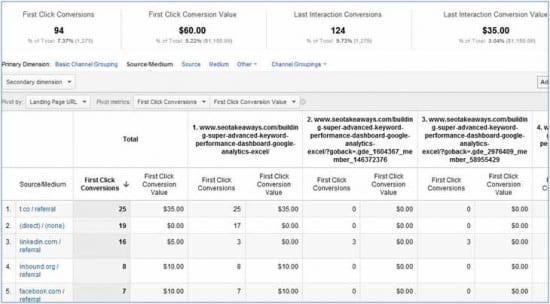
Here we see that my blog post got 94 first click conversions and the total value of these conversions is $60. However this is not really a true economic value of my post as I didn’t assign goal value to all of my goals. So you should always check how the data is collected before you do first impressions analysis or any other analysis.
The good news is that my blog post has added at least some value to the business bottom line. From the table you can also see the distribution of first click conversions among various acquisition channels (twitter, direct, linkedin, inbound etc). This can help you in deciding the acquisition channels you should primarily focus onto promote your content. In my case Twitter has resulted in maximum number of first click conversions followed by direct traffic and LinkedIn.
I have not used ‘last click conversions’ to evaluate the performance of a new piece of content mainly because in case of last click conversions a visitor has already been exposed to multiple touch points (like other contents on the site, promotional campaigns etc). So it becomes hard to evaluate the actual performance of a newly launched content.
Some points to consider regarding first impression analysis
- I would recommend waiting for at least 2 to 3 days after the launch of your new content before you do the first impression analysis. This is because multi channel funnel data collection lags by up to 2 days so you won’t immediately see data for your new content in ‘assisted conversions’ report.
- I would recommend waiting for at least a week after the launch of your new content before you report the results of your first impression analysis. This is because your new piece of content is most likely to continue to attract traffic and generate conversions for at least a week.
An E-Commerce Content Dashboard
This is the dashboard I use often to measure the performance of the most profitable contents (usually product pages or product category pages) for my e-commerce clients. To create this dashboard follows the steps given below:
Step-1: Head to ‘All Pages’ report (under Content > Site Content)
Step-2: Click on the pivot table button and create a pivot table with following specifications:
- Primary Dimension – Page Title
- Pivot By: Source
- Pivot Metrics: Page Value
Step-3: Say I want to analyze the performance of all the product pages in the ‘tees’ category because it is one of my top selling product category. So I will create an advanced filter on the reporting interface to filter out all the product pages. I will also compare the performance of my tees product pages with last month to understand whether or not I am making a progress in my content marketing and conversions optimization.
If I am making a progress then the page value of individual product pages and overall page value must increase over time:

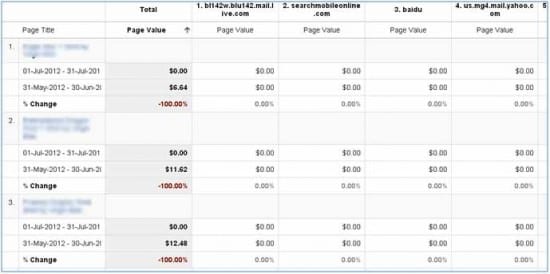
Here I have sorted the ‘page value’ column in decreasing order so that I can quickly see all those pages which are losing page value. Since these pages belong to one of my best selling product category, I need to find ways to improve their page values, so that I can increase the overall conversion volumes and sales of the ‘tees’ products. In my ‘profit index’ post I have talked about different ways to improve the page values of your profitable pages.
One last point. Focus on analyzing the performance of most profitable pages on your website. Remember the 80-20 rule. 80% of your sales come from 20% of the products. 80% of the output comes from 20% of the input. So don’t spread your marketing efforts and resources too thin trying to analyze and optimize each and every product/category page esp. if you have thousands or tens of thousands of product pages.
About the Author: Himanshu Sharma is the founder of seotakeaways.com which provides SEO Consultation, PPC Management and Analytics Consultation services to businesses of all size. He holds a bachelors degree in ‘Computer Science’, is a member of 'Digital Analytics Association' and is also a Google Analytics Certified Individual. He is also the founder of EventEducation.com and EventPlanningForum.net.














